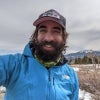Heading out the door? Read this article on the new Outside+ app available now on iOS devices for members! Download the app.
When the fire started, Kai Cranmore was meditating.
One the morning of January 7, Cranmore and five of his friends had set out to run a roughly 4-mile loop through Temescal Canyon, a steep, chaparral-blanketed hike that climbs up to views of Pacific Palisades and the ocean beyond. The forecast called for heavy winds; that wasn’t enough to scare off the group, who were experienced hikers and often rock climbed together.
They stopped along the trail at a promontory called Skull Rock for what Cranmore calls a crowdsourced meditation. The hikers sat on the rock with their eyes closed and their shoes off, occasionally speaking up to share what they felt in the moment.
“We were expressing what we were feeling,” said Cranmore, who has lived in Los Angeles for seven years. “I would say ‘I feel the gravity pulling me towards the earth’ or ‘I feel my breath.’ And my buddy Mike was like, ‘I smell smoke.’”
When the hikers opened their eyes and looked behind them, they saw a thick plume of smoke rolling over the hill toward them. Cranmore guessed it was no more than 50 yards away.
That smoke emanated from what would become known as the Palisades Fire, which has since spread to more than 21,000 acres and currently stands at just 8 percent containment despite fire crews’ best efforts to control it. Fueled by dry conditions and fanned by Santa Ana winds, it and several other major fires burning in the Los Angeles area have caused catastrophic damage this week, killing 10 people, displacing more than 170,000, and blanketing the metro area in a choking haze. They are already the costliest fires in U.S. history, with analysts estimating the economic losses from them at as high as $150 billion.
The following video contains strong language
But on Tuesday, all Cranmore and his friends knew was that they had to get away from the encroaching blaze, fast. They scrambled down the rock, tied on their shoes, and began to run. Because the ridge where the fire was burning stood between them and the trailhead, they briefly ran toward it, then started hustling down the trail. An artist and film director by trade, Cranmore instinctively pulled out his phone and began to film as he ran. Turning a corner, he looked back and saw the rock where the group had been sitting engulfed in “15-foot flames.”
The going was tough; the video shows the group running through brush and scrambling up and past rock formations. As they fled, the hikers called out rocks in the path to each other, mindful of the consequences of turning an ankle.
“It was full fight or flight,” said Cranmore. “You can’t fight a fire, so it was just pure flight.”
The group of friends relaxed a bit once the trail reached a creek lower in the canyon. As they descended, Cranmore said, they met a few people still hiking up and warned them about the fire; while most heeded their advice and turned around, a few kept heading up, curious to see the conflagration. “I felt as if we did our due diligence to advise them to steer clear,” Cranmore said. As they reached the parking area, fire trucks were beginning to arrive.
“In that moment, we didn’t really think about what a small fire could have grown into,” Cranmore says. “The only thought in my mind was to survive and get out of there. But my mind is just absolutely blown with how big it’s grown and how many lives it’s affected.”
Three days after his experience, Cranmore has begun to process the enormity of what he witnessed. Like many residents of L.A., he knows people who have been affected by the fires, which have consumed more than 10,000 buildings. Several members of the group who were with him that day have had to evacuate, he said, and a relative of his who lives in Topanga Canyon lost their home. When the fire is under control and the closures are lifted, he plans to go up and see if he can recover any of their family heirlooms.
In the meantime, he says, he’s focused on what he can do for the people closest to him.
“I’m here for my friends, and I think this is a time where everyone needs to come together and be strong,” said Cranmore.
Readers who want to support recovery efforts from the Los Angeles wildfires can donate to the California Community Foundation and GoFundMe’s 2025 Wildfire Relief Fund.
From 2025
